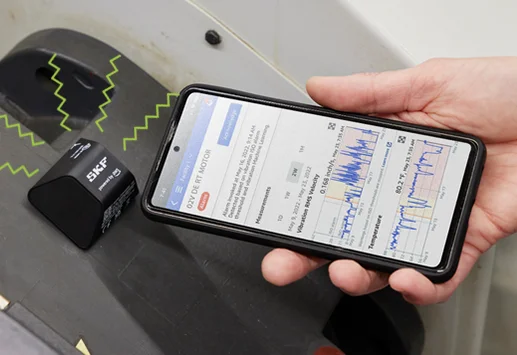The 3 Basic Characteristics Measured in Vibration

When it comes to machinery maintenance, vibration is one of the most reliable indicators of a machine’s health. Whether you're monitoring rotating equipment or diagnosing a fault, understanding vibration and how to measure it helps you make smarter, faster decisions.
Let’s break it down into the three essential characteristics you need to know: Displacement, Acceleration and Velocity.
Displacement
Displacement tells us how far something moves; in this case, the distance between a rotating object and the sensor monitoring it. Since vibration-related movement is often tiny, it’s typically measured in millimetres (mm).
Displacement is especially useful for detecting low-frequency vibrations, generally below five times the running speed of slow-moving machinery. It is commonly used to uncover faults such as:
- Eccentricity
- Unbalance
- Misalignment
Acceleration
Acceleration measures how quickly velocity changes over time. In vibration analysis, it is usually expressed in metres per second squared (m/s²) or gravity, “g”.
Acceleration is most effective when detecting high-frequency vibrations, particularly those caused by impacts. It is useful for identifying:
- Bearing wear or defects (such as damage to rolling elements or races)
- Gear faults (cracked or worn teeth, gear eccentricity, backlash)
Velocity
Velocity is the rate at which displacement changes; essentially, how fast the movement is happening. You will usually see this measured in millimetres per second (mm/s) or inches per second (IPS).
Why is velocity so widely used? Because it strikes a balance. It captures useful detail from both low and high-frequency vibrations, making it ideal for most machinery. Velocity can help identify:
- Unbalance
- Misalignment
- Mechanical looseness
- Propeller or impeller issues
How does an accelerometer measure vibration?
To capture vibration data, we use a sensor called an accelerometer. Standard accelerometers measure acceleration using the Piezoelectric Effect, converting mechanical movement into electrical signals.
A triaxial accelerometer is often the better choice for a more complete picture. These sensors measure vibration in three directions (or axes) and can track all three characteristics (displacement, acceleration, and velocity) simultaneously. This provides a much fuller and more detailed understanding of how your machine is performing.
How is vibration measured?
The most effective way to measure vibration is by fitting sensors directly to rotating equipment. A good example is the SKF Axios system, which uses triaxial sensor technology supported by machine learning.
Axios continuously monitors both vibration and temperature. It detects anomalies and sends alerts before minor issues develop into costly breakdowns. With data collected across all three axes, you can not only confirm that something is wrong but also pinpoint exactly what the issue is and why it is happening.
Conclusion
Vibration analysis does not need to be complicated. By understanding the three core characteristics and using the right tools, you can stay ahead of potential problems and keep your machinery running smoothly.
At ACORN, we are here to help you make sense of the data and get the best from your equipment. Because when your machinery performs better, your business does, too.
